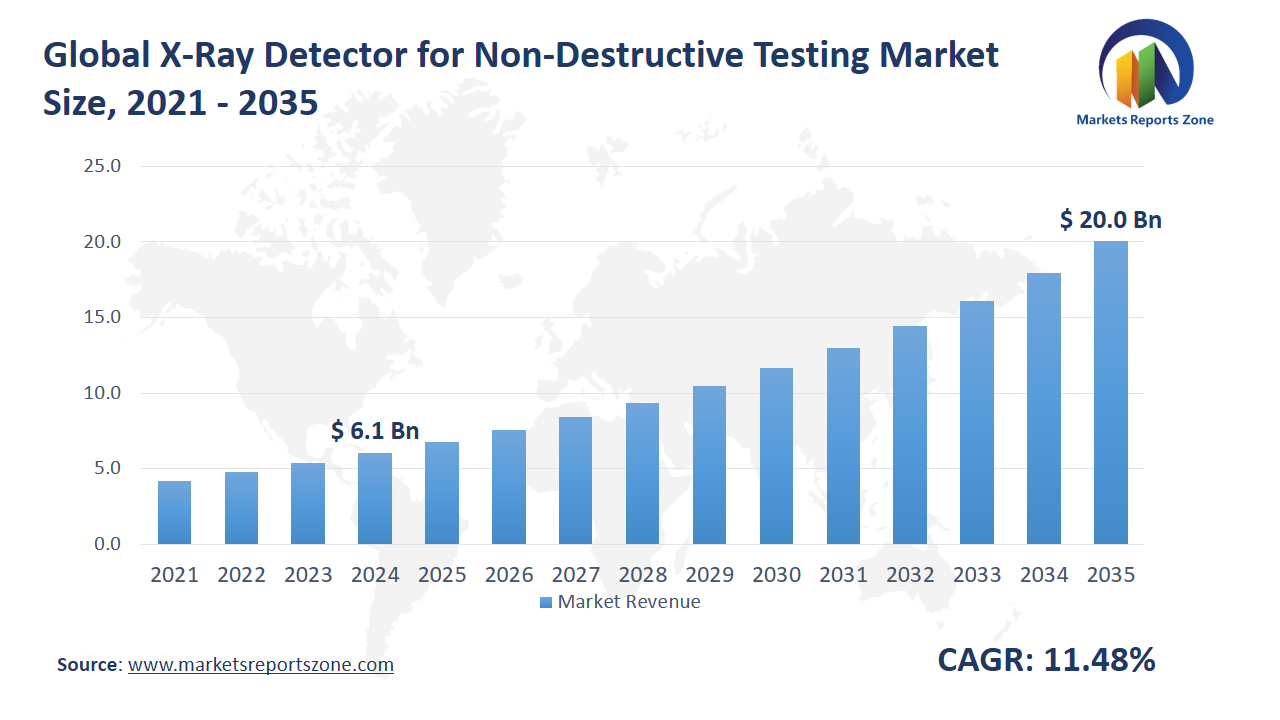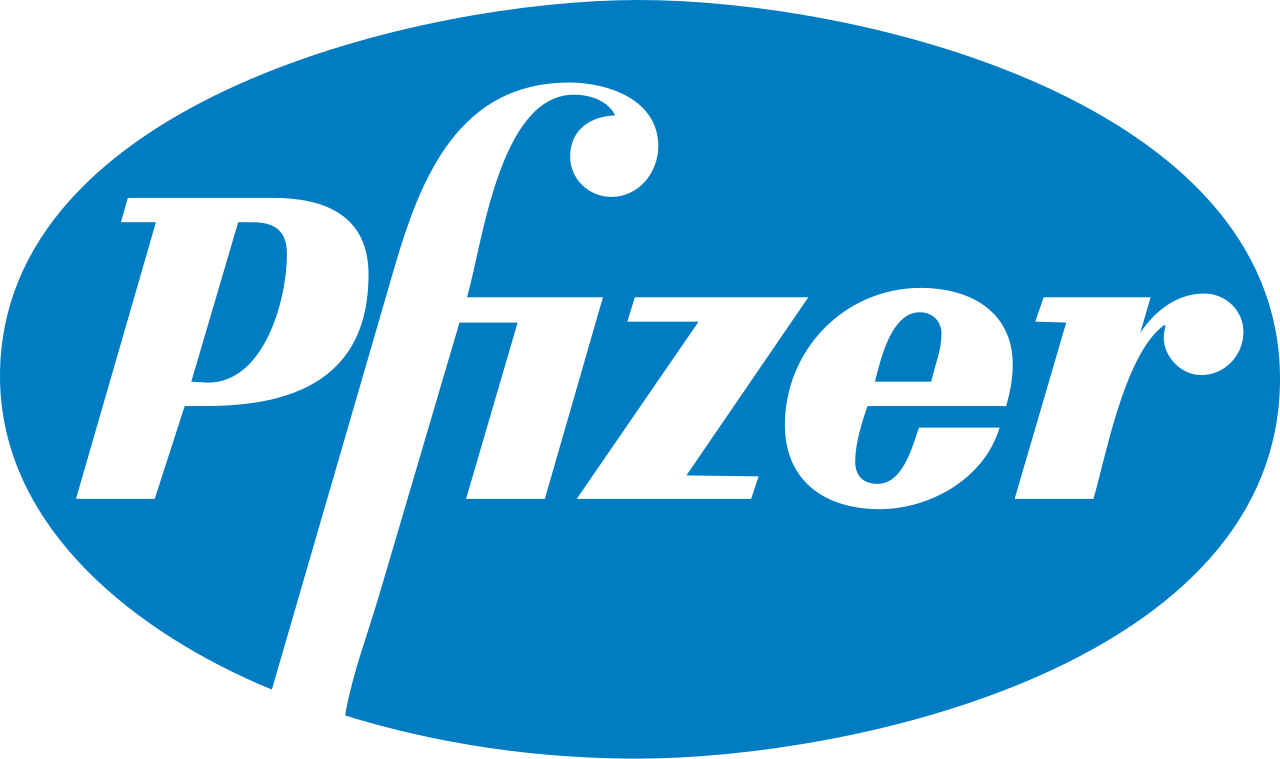Global X-Ray Detector for Non-Destructive Testing Market Size is expected to reach USD 20.03 Billion by 2035 from USD 6.06 Billion in 2024, with a CAGR of around 11.48% between 2024 and 2035. The global X-ray detector for non-destructive testing market is driven by the rising need for quality control and safety in industries. Increased adoption in aerospace and automotive sectors enhances demand. Strict regulations in manufacturing further push market growth. However, high initial costs act as a major restraint, limiting adoption in small-scale industries. Advancements in digital imaging technology create opportunities for enhanced accuracy. Growing use in infrastructure inspection offers further growth potential. In aerospace, aircraft components are checked for defects using X-ray detectors, ensuring safety. Automotive manufacturers use these systems to inspect welds and materials, preventing failures. Digital X-ray detectors improve efficiency and reduce inspection time in industrial settings. Pipeline maintenance benefits from this technology, detecting internal cracks before failures occur. Bridges and tunnels are inspected to ensure structural integrity, preventing catastrophic incidents. The food and pharmaceutical industries also benefit, detecting foreign objects in products. Miniaturization of detectors enhances portability, expanding their usability across industries. Increased investment in automation and AI-driven inspections further improves accuracy and reliability. Overall, the market continues to evolve with technological advancements. Adoption is expected to rise as costs reduce over time. The future remains promising for industries relying on non-destructive testing solutions.

Driver: Strict Regulations Boost Market Growth
Strict regulations drive the adoption of X-ray detectors in non-destructive testing. Industries must comply with stringent safety and quality standards to avoid failures. In the oil and gas sector, pipelines are inspected to detect corrosion and leaks before disasters occur. Government agencies mandate regular checks to prevent environmental damage. In nuclear power plants, reactor components are examined for cracks, ensuring long-term safety. Failure to comply with these regulations results in heavy penalties and operational shutdowns. Shipbuilding companies also rely on X-ray testing to inspect welds in vessels, preventing structural weaknesses. In railway maintenance, tracks and axles are scanned for internal defects, reducing accident risks. Construction projects undergo rigorous inspections to meet building codes, ensuring durability and safety. Medical device manufacturers use X-ray systems to verify product integrity before market release. These strict policies create a growing demand for advanced X-ray detectors with high precision and reliability. Companies invest in innovative solutions to meet evolving regulatory standards. As industries continue to prioritize safety and compliance, the demand for non-destructive testing solutions rises. The market benefits from this ongoing trend, pushing technological advancements and wider adoption across multiple sectors.
Key Insights:
- The adoption rate of X-ray detectors for non-destructive testing (NDT) in the aerospace industry is approximately 75%.
- Government investments in NDT technologies, including X-ray detectors, have reached around $150 million in recent years to enhance infrastructure safety.
- In 2023, the total number of X-ray detector units sold for NDT applications was estimated at 25,000 units globally.
- The penetration rate of X-ray detectors in the automotive sector is reported to be about 60%, driven by stringent safety regulations.
- Approximately 40% of manufacturing companies have integrated X-ray NDT systems into their quality assurance processes.
- The healthcare industry has seen a growth in investment in X-ray NDT technologies, with funding exceeding $100 million over the past two years.
- The oil and gas sector has experienced a significant increase in the use of X-ray detectors, with a reported growth rate of 5.4% annually.
- Regulatory bodies have mandated that 90% of critical infrastructure projects utilize advanced NDT methods, including X-ray detection, to ensure safety and compliance.
Segment Analysis:
The X-ray detector market for non-destructive testing is segmented by type and application, each playing a crucial role in various industries. CR systems are used in cost-sensitive applications, offering reliable imaging in basic inspections. Static flat panel detectors provide high-resolution images, ideal for aerospace component analysis. Dynamic flat panel detectors enhance real-time imaging, widely used in automated quality control. Linear sensors help inspect long and narrow objects like pipelines and aircraft fuselage. In aerospace and defense, X-ray detectors ensure aircraft turbines and military vehicle armor meet strict safety standards. Automotive manufacturers scan engine blocks and chassis for internal defects before assembly. The construction industry relies on these detectors for inspecting high-rise building beams and bridges to prevent structural failures. In electronics and semiconductors, microchips and circuit boards are scanned to detect microscopic faults before mass production. The energy and power sector benefits from these technologies by inspecting wind turbine blades and power plant boilers for early signs of wear. As industries demand faster, more precise inspections, advanced detectors continue to gain traction. The integration of AI and automation further enhances detection accuracy, ensuring improved safety and efficiency across all applications. The market remains dynamic, driven by innovation and evolving industrial needs.
Regional Analysis:
The global X-ray detector market for non-destructive testing varies across regions, driven by industry demands and technological advancements. In North America, aerospace and automotive industries fuel growth, with aircraft manufacturers using advanced X-ray detectors to inspect landing gears and jet engine turbines. Europe emphasizes strict quality regulations, pushing automotive firms to adopt high-resolution X-ray systems for inspecting electric vehicle battery cells. The Asia-Pacific region experiences rapid industrialization, with electronics manufacturers in countries like China and South Korea using these detectors to check semiconductor wafers for microscopic defects. In Latin America, infrastructure projects drive demand, with construction firms using X-ray technology to assess the integrity of concrete structures in earthquake-prone areas. The Middle East and Africa see growing adoption, especially in the oil and gas sector, where companies use X-ray systems to inspect offshore drilling equipment for corrosion and cracks. Advancements in digital imaging and AI integration improve accuracy and efficiency across all regions. The demand for portable and automated solutions continues to rise, enabling industries to enhance safety and reduce operational risks. As global industries evolve, X-ray detection technology plays a crucial role in ensuring reliability, compliance, and long-term sustainability across diverse applications.
Competitive Scenario:
The non-destructive testing (NDT) equipment market is witnessing significant advancements driven by key industry players. Companies like Comet, Fujifilm, Teledyne Dalsa, Rigaku, Shimadzu, Vidisco, QSA Global, SEC, Marietta, Spellman, Dandong NDT Equipment, DanDong HuaRI Science Electric, and Shenzhen Zoan are at the forefront of innovation, enhancing the quality and efficiency of NDT solutions. Recent developments include the introduction of portable X-ray systems that offer high-resolution imaging for on-site inspections, catering to industries such as oil & gas, aerospace & defense, and automotive. Advancements in digital imaging technology have led to the development of dynamic flat panel detectors, providing real-time imaging capabilities that improve defect detection in complex structures. For instance, in the energy sector, these detectors are utilized to inspect wind turbine blades for internal flaws, ensuring structural integrity and performance. Additionally, the integration of artificial intelligence and machine learning algorithms into NDT equipment has enabled automated defect recognition, reducing human error and increasing inspection speed. This is particularly beneficial in the construction industry, where timely assessments of infrastructure components like steel beams and concrete pillars are critical for safety and compliance. As these companies continue to invest in research and development, the NDT equipment market is poised for sustained growth, driven by the demand for more accurate, efficient, and user-friendly inspection technologies across various sectors.
X-Ray Detector for Non-Destructive Testing Market Report Scope
| Report Attribute | Details |
|---|
| Market Size Value in 2024 | USD 6.06 Billion |
| Revenue Forecast in 2035 | USD 20.03 Billion |
| Growth Rate | CAGR of 11.48% from 2025 to 2035 |
| Historic Period | 2021 - 2024 |
| Forecasted Period | 2025 - 2035 |
| Report Coverage | Revenue forecast, company ranking, competitive landscape, growth factors, and trends |
| Regions Covered | North America; Europe; Asia Pacific; Latin America; Middle East & Africa |
| Countries Covered | U.S.; Canada; Mexico, UK; Germany; France; Spain; Italy; Russia; China; Japan; India; South Korea; Australia; Southeast Asia; Brazil; Argentina; Saudi Arabia; UAE; South Africa |
| Key companies profiled | Comet; Fujifilm; Teledyne Dalsa; Rigaku; Shimadzu; Vidisco; QSA Global; SEC; Marietta; Spellman; Dandong NDT Equipment; DanDong HuaRI Science Electric; Shenzhen Zoan |
| Customization | Free report customization (equivalent up to 8 analysts working days) with purchase. Addition or alteration to country, regional & segment scope. |
The Global X-Ray Detector for Non-Destructive Testing Market report is segmented as follows:
By Type,
- CR System
- Static Flat Panel Detector (FLAT PANEL DETECTOR)
- Dynamic FLAT PANEL DETECTOR
- Linear Sensor
By Application,
- Aerospace & Defense
- Automotive
- Construction
- Electronic & Semiconductors
- Energy & Power
By Region,
- North America
- Europe
- UK
- Germany
- France
- Spain
- Italy
- Russia
- Rest of Europe
- Asia Pacific
- China
- Japan
- India
- South Korea
- Australia
- Southeast Asia
- Rest of Asia Pacific
- Latin America
- Brazil
- Argentina
- Rest of Latin America
- Middle East & Africa
- Saudi Arabia
- UAE
- South Africa
- Rest of Middle East and Africa
Key Market Players,
- Comet
- Fujifilm
- Teledyne Dalsa
- Rigaku
- Shimadzu
- Vidisco
- QSA Global
- SEC
- Marietta
- Spellman
- Dandong NDT Equipment
- DanDong HuaRI Science Electric
- Shenzhen Zoan
Frequently Asked Questions
Global X-Ray Detector for Non-Destructive Testing Market Size was valued at USD 6.06 Billion in 2024 and is projected to reach at USD 20.03 Billion in 2035.
Global X-Ray Detector for Non-Destructive Testing Market is expected to grow at a CAGR of around 11.48% during the forecasted year.
North America, Asia Pacific and Europe are major regions in the global X-Ray Detector for Non-Destructive Testing Market.
Key players analyzed in the global X-Ray Detector for Non-Destructive Testing Market are Comet; Fujifilm; Teledyne Dalsa; Rigaku; Shimadzu; Vidisco; QSA Global; SEC; Marietta; Spellman; Dandong NDT Equipment; DanDong HuaRI Science Electric; Shenzhen Zoan and so on.
Research Objectives
- Proliferation and maturation of trade in the global X-Ray Detector for Non-Destructive Testing Market.
- The market share of the global X-Ray Detector for Non-Destructive Testing Market, supply and demand ratio, growth revenue, supply chain analysis, and business overview.
- Current and future market trends that are influencing the growth opportunities and growth rate of the global X-Ray Detector for Non-Destructive Testing Market.
- Feasibility study, new market insights, company profiles, investment return, market size of the global X-Ray Detector for Non-Destructive Testing Market.
Chapter 1 X-Ray Detector for Non-Destructive Testing Market Executive Summary
- 1.1 X-Ray Detector for Non-Destructive Testing Market Research Scope
- 1.2 X-Ray Detector for Non-Destructive Testing Market Estimates and Forecast (2021-2035)
- 1.2.1 Global X-Ray Detector for Non-Destructive Testing Market Value and Growth Rate (2021-2035)
- 1.2.2 Global X-Ray Detector for Non-Destructive Testing Market Price Trend (2021-2035)
- 1.3 Global X-Ray Detector for Non-Destructive Testing Market Value Comparison, by Type (2021-2035)
- 1.3.1 CR System
- 1.3.2 Static Flat Panel Detector (FLAT PANEL DETECTOR)
- 1.3.3 Dynamic FLAT PANEL DETECTOR
- 1.3.4 Linear Sensor
- 1.4 Global X-Ray Detector for Non-Destructive Testing Market Value Comparison, by Application (2021-2035)
- 1.4.1 Aerospace & Defense
- 1.4.2 Automotive
- 1.4.3 Construction
- 1.4.4 Electronic & Semiconductors
- 1.4.5 Energy & Power
Chapter 2 Research Methodology
- 2.1 Introduction
- 2.2 Data Capture Sources
- 2.2.1 Primary Sources
- 2.2.2 Secondary Sources
- 2.3 Market Size Estimation
- 2.4 Market Forecast
- 2.5 Assumptions and Limitations
Chapter 3 Market Dynamics
- 3.1 Market Trends
- 3.2 Opportunities and Drivers
- 3.3 Challenges
- 3.4 Market Restraints
- 3.5 Porter's Five Forces Analysis
Chapter 4 Supply Chain Analysis and Marketing Channels
- 4.1 X-Ray Detector for Non-Destructive Testing Supply Chain Analysis
- 4.2 Marketing Channels
- 4.3 X-Ray Detector for Non-Destructive Testing Suppliers List
- 4.4 X-Ray Detector for Non-Destructive Testing Distributors List
- 4.5 X-Ray Detector for Non-Destructive Testing Customers
Chapter 5 COVID-19 & Russia?Ukraine War Impact Analysis
- 5.1 COVID-19 Impact Analysis on X-Ray Detector for Non-Destructive Testing Market
- 5.2 Russia-Ukraine War Impact Analysis on X-Ray Detector for Non-Destructive Testing Market
Chapter 6 X-Ray Detector for Non-Destructive Testing Market Estimate and Forecast by Region
- 6.1 Global X-Ray Detector for Non-Destructive Testing Market Value by Region: 2021 VS 2023 VS 2035
- 6.2 Global X-Ray Detector for Non-Destructive Testing Market Scenario by Region (2021-2023)
- 6.2.1 Global X-Ray Detector for Non-Destructive Testing Market Value Share by Region (2021-2023)
- 6.3 Global X-Ray Detector for Non-Destructive Testing Market Forecast by Region (2024-2035)
- 6.3.1 Global X-Ray Detector for Non-Destructive Testing Market Value Forecast by Region (2024-2035)
- 6.4 Geographic Market Analysis: Market Facts and Figures
- 6.4.1 North America X-Ray Detector for Non-Destructive Testing Market Estimates and Projections (2021-2035)
- 6.4.2 Europe X-Ray Detector for Non-Destructive Testing Market Estimates and Projections (2021-2035)
- 6.4.3 Asia Pacific X-Ray Detector for Non-Destructive Testing Market Estimates and Projections (2021-2035)
- 6.4.4 Latin America X-Ray Detector for Non-Destructive Testing Market Estimates and Projections (2021-2035)
- 6.4.5 Middle East & Africa X-Ray Detector for Non-Destructive Testing Market Estimates and Projections (2021-2035)
Chapter 7 Global X-Ray Detector for Non-Destructive Testing Competition Landscape by Players
- 7.1 Global Top X-Ray Detector for Non-Destructive Testing Players by Value (2021-2023)
- 7.2 X-Ray Detector for Non-Destructive Testing Headquarters and Sales Region by Company
- 7.3 Company Recent Developments, Mergers & Acquisitions, and Expansion Plans
Chapter 8 Global X-Ray Detector for Non-Destructive Testing Market, by Type
- 8.1 Global X-Ray Detector for Non-Destructive Testing Market Value, by Type (2021-2035)
- 8.1.1 CR System
- 8.1.2 Static Flat Panel Detector (FLAT PANEL DETECTOR)
- 8.1.3 Dynamic FLAT PANEL DETECTOR
- 8.1.4 Linear Sensor
Chapter 9 Global X-Ray Detector for Non-Destructive Testing Market, by Application
- 9.1 Global X-Ray Detector for Non-Destructive Testing Market Value, by Application (2021-2035)
- 9.1.1 Aerospace & Defense
- 9.1.2 Automotive
- 9.1.3 Construction
- 9.1.4 Electronic & Semiconductors
- 9.1.5 Energy & Power
Chapter 10 North America X-Ray Detector for Non-Destructive Testing Market
- 10.1 Overview
- 10.2 North America X-Ray Detector for Non-Destructive Testing Market Value, by Country (2021-2035)
- 10.2.1 U.S.
- 10.2.2 Canada
- 10.2.3 Mexico
- 10.3 North America X-Ray Detector for Non-Destructive Testing Market Value, by Type (2021-2035)
- 10.3.1 CR System
- 10.3.2 Static Flat Panel Detector (FLAT PANEL DETECTOR)
- 10.3.3 Dynamic FLAT PANEL DETECTOR
- 10.3.4 Linear Sensor
- 10.4 North America X-Ray Detector for Non-Destructive Testing Market Value, by Application (2021-2035)
- 10.4.1 Aerospace & Defense
- 10.4.2 Automotive
- 10.4.3 Construction
- 10.4.4 Electronic & Semiconductors
- 10.4.5 Energy & Power
Chapter 11 Europe X-Ray Detector for Non-Destructive Testing Market
- 11.1 Overview
- 11.2 Europe X-Ray Detector for Non-Destructive Testing Market Value, by Country (2021-2035)
- 11.2.1 UK
- 11.2.2 Germany
- 11.2.3 France
- 11.2.4 Spain
- 11.2.5 Italy
- 11.2.6 Russia
- 11.2.7 Rest of Europe
- 11.3 Europe X-Ray Detector for Non-Destructive Testing Market Value, by Type (2021-2035)
- 11.3.1 CR System
- 11.3.2 Static Flat Panel Detector (FLAT PANEL DETECTOR)
- 11.3.3 Dynamic FLAT PANEL DETECTOR
- 11.3.4 Linear Sensor
- 11.4 Europe X-Ray Detector for Non-Destructive Testing Market Value, by Application (2021-2035)
- 11.4.1 Aerospace & Defense
- 11.4.2 Automotive
- 11.4.3 Construction
- 11.4.4 Electronic & Semiconductors
- 11.4.5 Energy & Power
Chapter 12 Asia Pacific X-Ray Detector for Non-Destructive Testing Market
- 12.1 Overview
- 12.2 Asia Pacific X-Ray Detector for Non-Destructive Testing Market Value, by Country (2021-2035)
- 12.2.1 China
- 12.2.2 Japan
- 12.2.3 India
- 12.2.4 South Korea
- 12.2.5 Australia
- 12.2.6 Southeast Asia
- 12.2.7 Rest of Asia Pacific
- 12.3 Asia Pacific X-Ray Detector for Non-Destructive Testing Market Value, by Type (2021-2035)
- 12.3.1 CR System
- 12.3.2 Static Flat Panel Detector (FLAT PANEL DETECTOR)
- 12.3.3 Dynamic FLAT PANEL DETECTOR
- 12.3.4 Linear Sensor
- 12.4 Asia Pacific X-Ray Detector for Non-Destructive Testing Market Value, by Application (2021-2035)
- 12.4.1 Aerospace & Defense
- 12.4.2 Automotive
- 12.4.3 Construction
- 12.4.4 Electronic & Semiconductors
- 12.4.5 Energy & Power
Chapter 13 Latin America X-Ray Detector for Non-Destructive Testing Market
- 13.1 Overview
- 13.2 Latin America X-Ray Detector for Non-Destructive Testing Market Value, by Country (2021-2035)
- 13.2.1 Brazil
- 13.2.2 Argentina
- 13.2.3 Rest of Latin America
- 13.3 Latin America X-Ray Detector for Non-Destructive Testing Market Value, by Type (2021-2035)
- 13.3.1 CR System
- 13.3.2 Static Flat Panel Detector (FLAT PANEL DETECTOR)
- 13.3.3 Dynamic FLAT PANEL DETECTOR
- 13.3.4 Linear Sensor
- 13.4 Latin America X-Ray Detector for Non-Destructive Testing Market Value, by Application (2021-2035)
- 13.4.1 Aerospace & Defense
- 13.4.2 Automotive
- 13.4.3 Construction
- 13.4.4 Electronic & Semiconductors
- 13.4.5 Energy & Power
Chapter 14 Middle East & Africa X-Ray Detector for Non-Destructive Testing Market
- 14.1 Overview
- 14.2 Middle East & Africa X-Ray Detector for Non-Destructive Testing Market Value, by Country (2021-2035)
- 14.2.1 Saudi Arabia
- 14.2.2 UAE
- 14.2.3 South Africa
- 14.2.4 Rest of Middle East & Africa
- 14.3 Middle East & Africa X-Ray Detector for Non-Destructive Testing Market Value, by Type (2021-2035)
- 14.3.1 CR System
- 14.3.2 Static Flat Panel Detector (FLAT PANEL DETECTOR)
- 14.3.3 Dynamic FLAT PANEL DETECTOR
- 14.3.4 Linear Sensor
- 14.4 Middle East & Africa X-Ray Detector for Non-Destructive Testing Market Value, by Application (2021-2035)
- 14.4.1 Aerospace & Defense
- 14.4.2 Automotive
- 14.4.3 Construction
- 14.4.4 Electronic & Semiconductors
- 14.4.5 Energy & Power
Chapter 15 Company Profiles and Market Share Analysis: (Business Overview, Market Share Analysis, Products/Services Offered, Recent Developments)
- 15.1 Comet
- 15.2 Fujifilm
- 15.3 Teledyne Dalsa
- 15.4 Rigaku
- 15.5 Shimadzu
- 15.6 Vidisco
- 15.7 QSA Global
- 15.8 SEC
- 15.9 Marietta
- 15.10 Spellman
- 15.11 Dandong NDT Equipment
- 15.12 DanDong HuaRI Science Electric
- 15.13 Shenzhen Zoan



